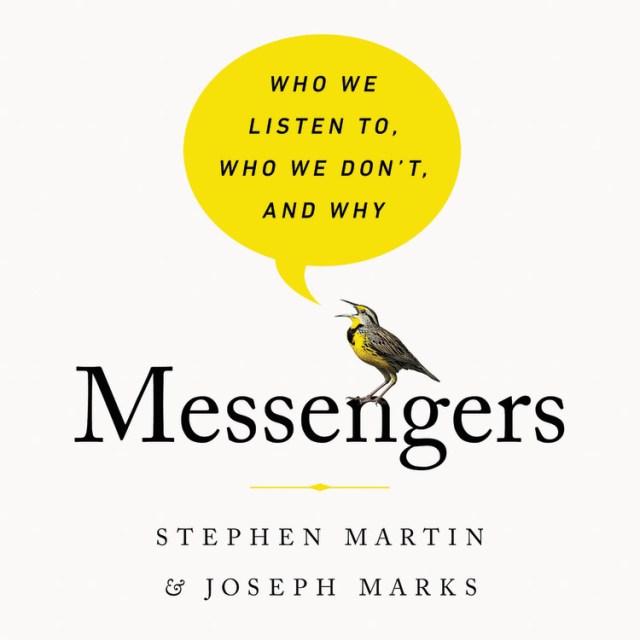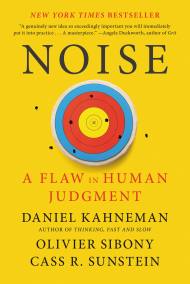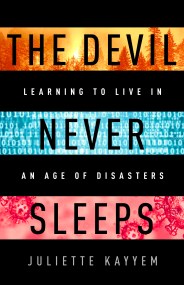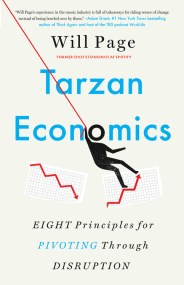Promotion
Use code MOM24 for 20% off site wide + free shipping over $45
Messengers
Who We Listen To, Who We Don't, and Why
Contributors
By Joseph Marks
Read by Sam Woolf
Formats and Prices
Format
Format:
- Audiobook Download (Unabridged)
- ebook $18.99 $24.99 CAD
- Hardcover $30.00 $38.00 CAD
This item is a preorder. Your payment method will be charged immediately, and the product is expected to ship on or around October 15, 2019. This date is subject to change due to shipping delays beyond our control.
Also available from:
“In the age of fake news, understanding who we trust and why is essential in explaining everything from leadership to power to our daily relationships.” -Sinan Aral
We live in a world where proven facts and verifiable data are freely and widely available. Why, then, are self-confident ignoramuses so often believed over thoughtful experts? And why do seemingly irrelevant details such as a person’s appearance or financial status influence whether or not we trust what they are saying, regardless of their wisdom or foolishness?
We live in a world where proven facts and verifiable data are freely and widely available. Why, then, are self-confident ignoramuses so often believed over thoughtful experts? And why do seemingly irrelevant details such as a person’s appearance or financial status influence whether or not we trust what they are saying, regardless of their wisdom or foolishness?
Stephen Martin and Joseph Marks compellingly explain how in our uncertain and ambiguous world, the messenger is increasingly the message. We frequently fail, they argue, to separate the idea being communicated from the person conveying it, explaining why the status or connectedness of the messenger has become more important than the message itself.
Messengers influence business, politics, local communities, and our broader society. And Martin and Marks reveal the forces behind the most infuriating phenomena of our modern era, such as belief in fake news and how presidents can hawk misinformation and flagrant lies yet remain.
Genre:
-
"In the age of fake news, understanding who we trust and why is essential to explaining everything from leadership to power to our daily relationships. With Messengers, Stephen Martin and Joseph Marks have given us the definitive book on the subject. Illuminating and entertaining, it helps us understand who we follow and why we follow them, in politics, business, and everyday life."Sinan Aral, David Austin Professor of Management at MIT and author of the forthcoming The Hype Machine
-
"Whenever we listen to a presentation, scroll through social media, or glance at the television, the question-Whom should we believe? -confronts us. Martin and Marks marshal an array of evidence to deliver a clear, compelling, and sometimes disturbing answer. Some books help us become better citizens. Others help us perform better at our jobs. This remarkable book somehow manages to do both. Messengers is an essential read for everyone."Daniel H. Pink, author of When, Drive, and A Whole New Mind
-
"A powerful, profoundly illuminating exploration of one of the most important subjects of our time. Martin and Marks have a terrific talent for combining evidence and research with lively and vivid writing. Trust these messengers!"Cass R. Sunstein, Robert Walmsley University Professor, Harvard University, and author of Conformity
-
"Engaging, informative, and entertaining. It will change the way you think about who you follow and take advice from."Tali Sharot, University College London, author of The Optimism Bias and The Influential Mind
-
"Messengers is a tour de force on this crucial topic. Thoroughly researched and timely, I can't think of any book that makes such a compelling case for the role and characteristics of the modern day messenger."Robert Cialdini, author of Influence: The Psychology of Persuasion
-
"Who do we believe, and why do we believe them? Messengers explains why we listen to the powerful-and sometimes the not so powerful-and what distinguishes the messengers we listen to from the ones we don't. A book that's as entertaining as it is timely and important."Adam Alter, New York University, author of Irresistible: The Rise of Addictive Technology and the Business of Keeping Us Hooked
-
"Robust....Messengers is useful in that it's designed to help consumers and citizens understand when they're being manipulated and take steps to resist."Harvard Business Review
-
"Almost everyone has had the experience of not being taken seriously -- even when their message was serious, founded on fact and relevant to the audience. You can get frustrated, or you can read Messengers: Who We Listen To, Who We Don't, and Why."Small Business Trends
- On Sale
- Oct 15, 2019
- Publisher
- Hachette Audio
- ISBN-13
- 9781549150029
Newsletter Signup
By clicking ‘Sign Up,’ I acknowledge that I have read and agree to Hachette Book Group’s Privacy Policy and Terms of Use








